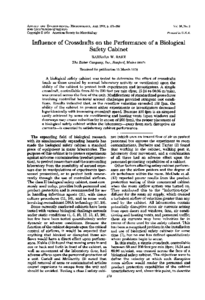Influence of crossdrafts on the performance of a biological safety cabinet

Applied and Environmental Microbiology
1978
36
2
278-283
air sampling ; health impact assessment ; laboratory ; research equipment ; microbiological pollution ; microorganisms ; personal protective equipment ; plant safety and health organization ; plant safety organization ; ventilation systems
English
"A biological safety cabinet was tested to determine the effect of crossdrafts (such as those created by normal laboratory activity or ventilation) upon the ability of the cabinet to protect both experiments and investigators. A simple crossdraft, controllable from 50 to 200 feet per min (fpm; 15.24 to 60.96 m/min), was created across the face of the unit. Modifications of standardized procedures involving controlled bacterial aerosol challenges provided stringent test conditions. Results indicated that, as the crossflow velocities exceeded 100 fpm, the ability of the cabinet to protect either experiments or investigators decreased logarithmically with increasing crossdraft speed. Because 100 fpm is an airspeed easily achieved by some air conditioning and heating vents (open windows and doorways may create velocities far in excess of 200 fpm), the proper placement of a biological safety cabinet within the laboratory--away from such disruptive air currents--is essential to satisfactory cabinet performance."
Digital
The ETUI is co-funded by the European Union. Views and opinions expressed are however those of the author(s) only and do not necessarily reflect those of the European Union or the ETUI.